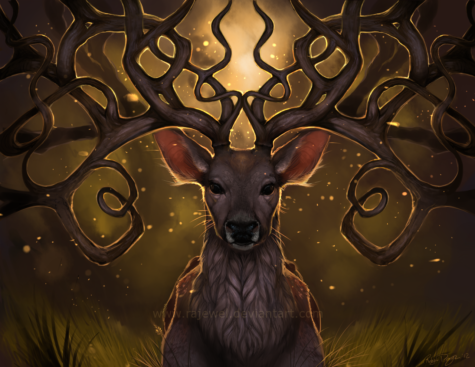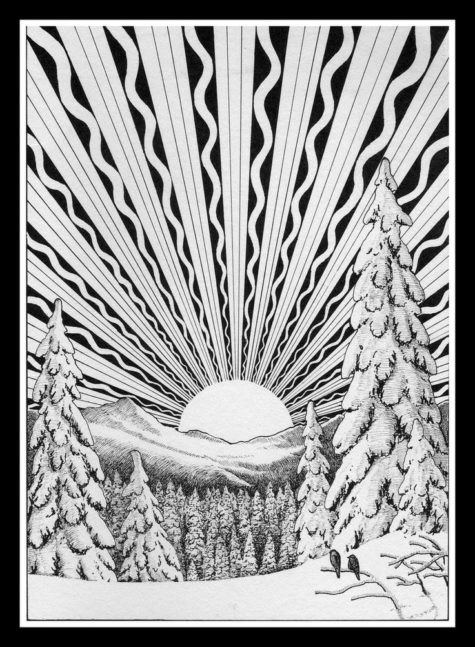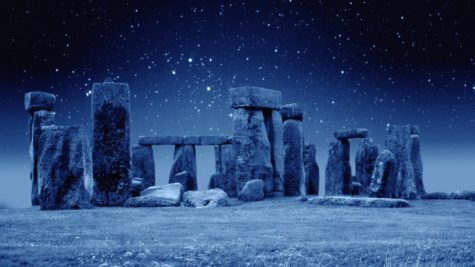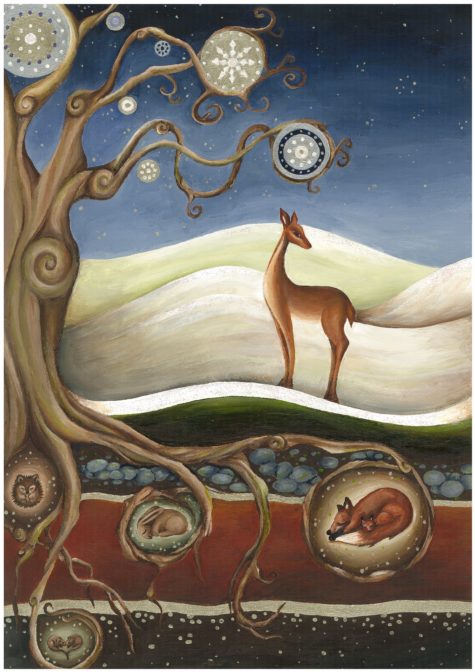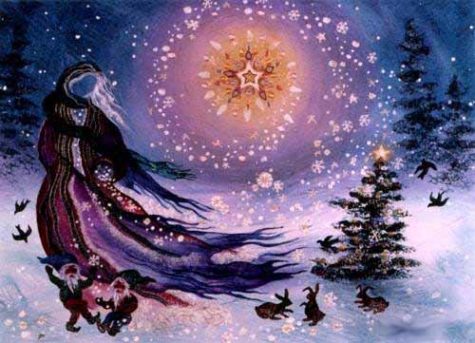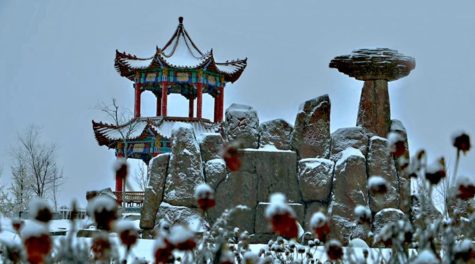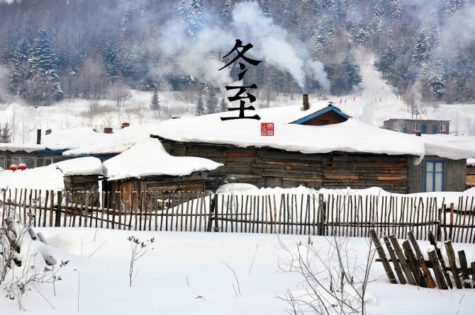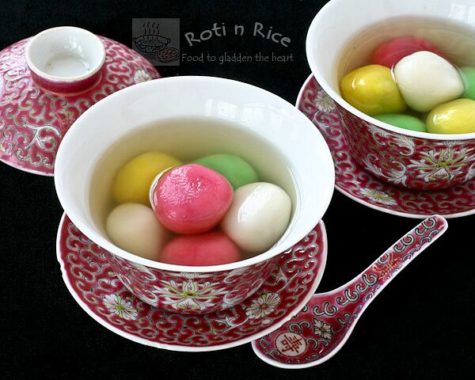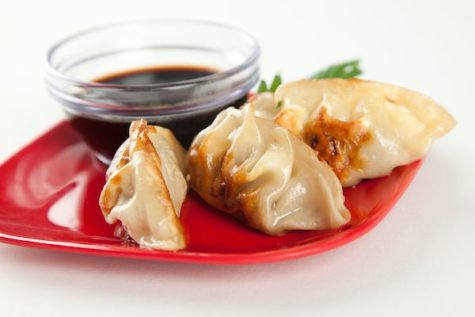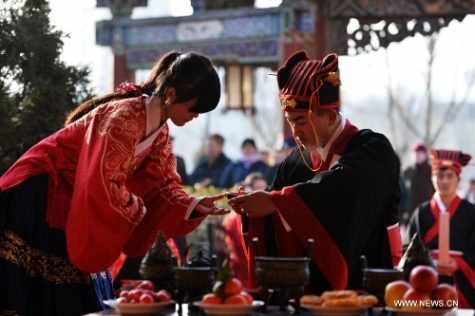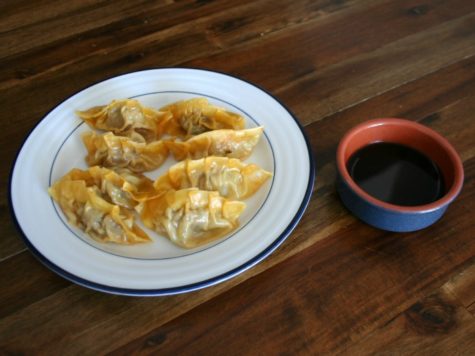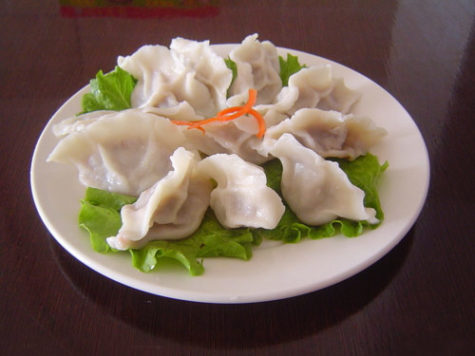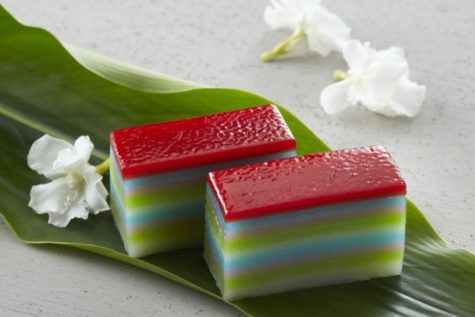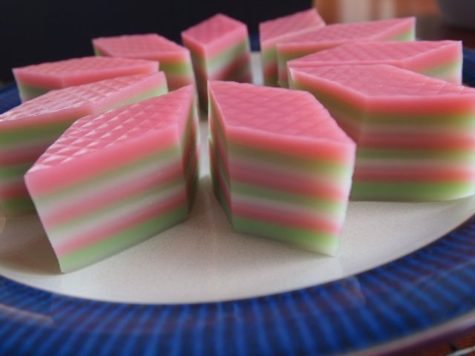Daily Archives: December 13, 2017
The Winter Solstice or Yule is one of the Lesser Wiccan Sabbats, and it is also the shortest day of the year, and hence – the longest night. This usually takes place on December 20th or 21st, although it does sometimes occur on the 22nd or 23rd (check your calendar as it changes from year to year).
Other than the most common name of Yule, various other names for the Winter Solstice include:
- Midwinter
- Yuletide (the Teutonic version)
- Alban Arthan (Caledonii Tradition, or the Druids)
- Feill Fionnain (Pecti-Wita Tradition, which falls on December 22nd).
Yuletide lasts from December 20th through December 31st. It begins on “Mother Night” and ends twelve days later, on “Yule Night”, hence the “Twelve Days of Christmas” tradition. Alban Arthan, unlike all the others, is not considered a fire festival.
Some other names for this Sabbat that are used less commonly are: Sun Return, Pagan New Year, Saturnalia (Roman), Great Day of the Cauldron, and Festival of Sol.
Yule is a time of the Goddess of the Cold Darkness and the birth of the Divine Child, the reborn Sun God. It is a time of renewal and rebirth during Winter, and the turning of the Earth force tides. A time when the waxing Sun overcomes the waning Sun. In some traditions, this is symbolized by the struggle between the Oak King and the Holly King.
The Holly King, represents the Death aspect of the God at this time of year; and the Oak King, represents the opposite aspect of Rebirth (these roles are reversed at Midsummer). This can be likened to the Divine Child’s birth. The myth of the Holly King/Oak King probably originated from the Druids to whom these two trees were highly sacred. The Oak King (God of the Waxing Year) kills the Holly King (God of the Waning Year) at Yule (the Winter Solstice). The Oak King then reigns supreme until Litha (the Summer Solstice) when the two battle again, this time with the Holly King victorious.
Examples of the Holly King’s image can be seen in our modern Santa Claus. He dons a sprig of holly in his hat, wears red clothing, and drives a team of eight (total number of Solar Sabbats) reindeer, an animal sacred to the Celtic Gods (deer). Mistletoe and holly came into modern Christmas celebrations through the memorializing of this battle. The holly with berries are hung in honor of the Holly King and mistletoe in honor of the Oak King. Although the Holly King and Oak King are mortal enemies at the two Solstices – Yule and Litha – it should be remembered that they are actually two sides of one whole, and neither would exist without the other.
Since this is a Solar Festival, it is celebrated by fire and the use of many candles orthe Yule Log. The colors of the season – red and green – are of original Pagan descent. Symbols representing Yule include an eight-spoked wheel symbol, evergreens, wreaths, holly, mistletoe, Yule Trees (very similar to the familiar “Christmas Trees”), or a small potted tree, and Yule Logs.
The act of decorating the Yule Tree, wreaths of holly, and the exchange of gifts are also Pagan derivatives. The Yule Tree can be a living, potted tree which can later be planted in the ground, a cut one, or even an artificial one. The choice is yours.
Appropriate Wiccan decorations range from strings of dried rosebuds, cinnamon sticks, popcorn or cranberries for garlands to bags of fragrant spices hung from boughs. Quartz crystals can be wrapped with shiny wire and suspended from sturdy branches to resemble icicles. Apples, oranges, lemons, nuts of all kinds and cookies hanging from boughs and branches are strikingly beautiful; and can be real or artificial, depending on your taste. These natural decorations were customary in ancient times. The reindeer stag is also a reminder of the Horned God. You will find that many traditional Christmas decorations have some type of Pagan ancestry or significance that can be added to your Yule holiday.
Deities to honor at this time of year include all Newborn Gods and Sun Gods, and all Mother Goddesses and Triple Goddesses. Appropriate Yule Gods include Apollo (Greek), Ra, Osiris, Horus, (all three are Egyptian), Lugh (Irish-Celtic), Odin (Norse), Father Sun (Native American), and Jesus (Christian-Gnostic), to name a few. Goddesses might include the Morrigan, Brigit (both Celtic), Isis (Egyptian), Demeter, Gaea, Pandora, Selene, and Artemis (all five are Greek), Juno and Diana (both Roman), Astarte (Middle Eastern), Spinning Woman (Native American) and the Virgin Mary (Christian-Gnostic).
Ritually, you may want to light fires within the Circle (in the cauldron, for instance), light candles and carry them around the Circle or bring the Yule log into the Circle and include it in your ceremony. Bayberry candles can be burned to ensure prosperity, growth and happiness throughout the following year. These can be inscribed with runes for health and money, or whatever is desired before lighting. They shall be lit at sunset and allowed to burn until they go out by themselves. An old Germanic poem says “A bayberry candle burned to the socket brings food to the larder and gold to the pocket.”
Spellwork for balance, beauty, peace, and harmony are great to perform at this time of the Pagan year. Love spells and spells to increase happiness are also appropriate. Key actions to remember for Yule are introspection and meditation.
The most common colors used at this Sabbat are red and green, but gold and white are also quite appropriate. Stones to be used at this celebration include bloodstones, rubies, and garnets. Animals associated with the Yule Sabbat are stags, squirrels, wrens and robins. Mythical creatures associated with Yule are the Phoenix, and trolls. Herbs and plants that can be used include holly, mistletoe, evergreens, poinsettias, bay, pine, ginger, valerian, and myrrh.
The foods of Yule include nuts, fruits such as apples and pears, cookies and cakes of caraway soaked in cider, and (for non-vegetarians) pork are all traditional fare. Fine drinks for the Yule celebration or meals include Wassail (a hot drink made from wine, beer or cider, spices, sugar, and usually baked apples—served in a large bowl), lamb’s wool (ale mixed with sugar, nutmeg and the pulp of roasted apples), hibiscus or ginger tea, and apple cider.
Source: Citadel of The Dragons
The winter solstice (or hibernal solstice), also known as midwinter, is an astronomical phenomenon marking the day with the shortest period of daylight and the longest night of the year. In the Northern Hemisphere this is the December solstice and in the Southern Hemisphere this is the June solstice.
The Winter Solstice has been celebrated for millennia by cultures and religions all over the world. Many modern pagan religions are descended in spirit from the ancient pre-Christian religions of Europe and the British Isles, and honor the divine as manifest in nature, the turning of the seasons, and the powerfully cyclical nature of life.
Worldwide, interpretation of the event has varied across cultures, but many have held a recognition of rebirth, involving holidays, festivals, gatherings, rituals or other celebrations around that time.
Most pagan religions are polytheistic, honoring both male and female deities, which are seen by some as two aspects of one non-gendered god, by others as two separate by complementing beings, and by others as entire pantheons of gods and goddesses.
It is common for the male god(s) to be represented in the sun, the stars, in summer grain, and in the wild animals and places of the earth. The stag is a powerful representation of the male god, who is often called “the horned god.”
The Goddess is most often represented in the earth as a planet, the moon, the oceans, and in the domestic animals and the cultivated areas of the earth.
In many pagan traditions the Winter Solstice symbolizes the rebirth of the sun god from his mother, the earth goddess. The Winter Solstice is only one of eight seasonal holidays celebrated by modern pagans.
Historical Notes
The solstice may have been a special moment of the annual cycle for some cultures even during neolithic times. Astronomical events were often used to guide activities such as the mating of animals, the sowing of crops and the monitoring of winter reserves of food.
Many cultural mythologies and traditions are derived from this. This is attested by physical remains in the layouts of late Neolithic and Bronze Age archaeological sites, such as Stonehenge in England and Newgrange in Ireland.
The primary axes of both of these monuments seem to have been carefully aligned on a sight-line pointing to the winter solstice sunrise (Newgrange) and the winter solstice sunset (Stonehenge). It is significant that at Stonehenge the Great Trilithon was oriented outwards from the middle of the monument, i.e. its smooth flat face was turned towards the midwinter Sun.
The winter solstice was immensely important because the people were economically dependent on monitoring the progress of the seasons. Starvation was common during the first months of the winter, January to April (northern hemisphere) or July to October (southern hemisphere), also known as “the famine months”.
In temperate climates, the midwinter festival was the last feast celebration, before deep winter began. Most cattle were slaughtered so they would not have to be fed during the winter, so it was almost the only time of year when a plentiful supply of fresh meat was available. The majority of wine and beer made during the year was finally fermented and ready for drinking at this time.
The concentration of the observances were not always on the day commencing at midnight or at dawn, but at the beginning of the pagan day, which in many cultures fell on the previous eve. Because the event was seen as the reversal of the Sun’s ebbing presence in the sky, concepts of the birth or rebirth of sun gods have been common and, in cultures which used cyclic calendars based on the winter solstice, the “year as reborn” was celebrated with reference to life-death-rebirth deities or “new beginnings” such as Hogmanay’s redding, a New Year cleaning tradition. Also “reversal” is yet another frequent theme, as in Saturnalia’s slave and master reversals.
A Winter Solstice reading:
This is the night of the Solstice, the longest night of the year. Now darkness triumphs, yet gives way and changes into light. The breath of Nature is suspended: all waits while within the Cauldron, the Dark King is transformed into the infant light. We watch for the coming of Dawn, when the great Mother again gives birth to the Divine child Sun, who is bringer of hope and the promise of summer. This is the stillness behind motion, when time itself stops; the center, which is also the circumference of all. We are awake in the Night. We turn the Wheel to bring the Light. We call the sun from the womb of night.
Celebrating the Winter Solstice
At the Winter Solstice we celebrate by bringing warmth, light and cheerfulness into this dark time of the year. Holidays such as this have their origins as “holy days”. They are the way human beings mark the sacred times in the yearly cycle of life.
On this shortest day of the year, the sun is at its lowest and weakest, a pivot point from which the light will grow stronger and brighter. This is the pivot point of the year. The Romans called it Dies Natalis Invicti Solis, the Birthday of the Unconquered Sun.
A simple way to celebrate this day is with a small candle lighting ceremony. The purpose being to celebrate this time of renewal in our lives, to give thanksgiving for the past and the present and to offer a blessing for the year to come.
- How to:
Create a small sacred space. Decorate it in a way that feels cheerful, warm, and bright. In the center place a white candle. As the sun sets on this day, light the candle, and say a few words about bringing the light forth in your life, in the lives of your family and loved ones in the coming year. Either allow the candle to burn out of it’s own accord, or relight it every evening until Jan 1st.
From Wikipedia and other sources
The Dōngzhì Festival or Winter Solstice Festival is one of the most important festivals celebrated by the Chinese and other East Asians during the Dōngzhì solar term (winter solstice) on or around December 22 when sunshine is weakest and daylight shortest.
The origins of this festival can be traced back to the yin and yang philosophy of balance and harmony in the cosmos. After this celebration, there will be days with longer daylight hours and therefore an increase in positive energy flowing in. The philosophical significance of this is symbolized by the I Ching hexagram fù (復, “Returning”).
To really get a feel for the Dōngzhì Festival, you have to imagine hard, rural living during a gray Han Dynasty winter more than 2,000 years ago.
Now picture a family meal at a table set with hearty, warming foods, raising the hopes for spring’s arrival. That’s the spirit of the Dōngzhì Festival.
The Dōngzhì Festival marries the winter solstice with nature’s harmonious balance of yin and yang energy. From this point forward, dongzhi (i.e. the extreme of winter) and the negative yin qualities of darkness and cold give way to the positive yang qualities of light and warmth. In other words, take heart — spring will come.
Traditional activities
Traditionally, the Dōngzhì Festival was a day to regroup with a family get together before tackling the last leg of winter. Today, with survival less of a daily concern and no time off granted, the Dōngzhì Festival is celebrated mostly with a family meal full of warm, hearty foods. One activity that occurs during these get togethers (especially in the southern parts of China and in Chinese communities overseas) is the making and eating of tangyuan, or balls of glutinous rice, which symbolize reunion.
Tangyuan are made of glutinous rice flour and sometimes brightly colored. Each family member receives at least one large tangyuan in addition to several small ones. The flour balls may be plain or stuffed. They are cooked in a sweet soup or savory broth with both the ball and the soup/broth served in one bowl. It is also often served with a mildly alcoholic unfiltered rice wine containing whole grains of glutinous rice (and often also Sweet Osmanthus flowers), called jiuniang.
- Here’s a recipe for Glutinous Rice Balls
In northern China, people typically eat dumplings on Dōngzhì. It is said to have originated from Zhang Zhongjing in the Han Dynasty. On one cold winter day, he saw the poor suffering from chilblains on their ears. Feeling sympathetic, he ordered his apprentices to make dumplings with lamb and other ingredients, and distribute them among the poor to keep them warm, to keep their ears from getting chilblains.
Since the dumplings were shaped like ears, Zhang named the dish “qùhán jiāoěr tāng” (祛寒嬌耳湯) or dumpling soup that expels the cold. From that time on, it has been a tradition to eat dumplings on the day of Dōngzhì.
- Here’s a recipe for Lamb Dumplings
Old traditions also require people with the same surname or from the same clan to gather at their ancestral temples to worship on this day. There is always a grand reunion dinner following the sacrificial ceremony.
The festive food is also a reminder that we are now a year older and should behave better in the coming year. Even today, many Chinese around the world, especially the elderly, still insist that one is “a year older” right after the Dōngzhì celebration instead of waiting for the Chinese New Year.
In Taiwan
To Taiwanese people, the festival in winter also plays a very important role. It is also a tradition for Taiwanese to eat tangyuan on this day. They also use the festive food as an offering dish to worship the ancestors.
In an interesting twist, in accordance with ancient Taiwanese history, many people take some of the tangyuan that have been used as offerings and stick them on the back of the door or on windows and tables and chairs. These “empowered” tangyuan supposedly serve as protective talismans to keep evil spirits from coming close to children.
 In addition to following some of the customs practiced in China, the people of Taiwan have their own unique custom of offering nine-layer cakes as a ceremonial sacrifice to worship their ancestors.
In addition to following some of the customs practiced in China, the people of Taiwan have their own unique custom of offering nine-layer cakes as a ceremonial sacrifice to worship their ancestors.
- Here’s a recipe for Nine Layer Cake
These cakes are made using glutinous rice flour in the shape of a chicken, duck, tortoise, pig, cow or sheep, and then steamed in different layers of a pot. These animals all signify auspiciousness in Chinese tradition.
Another interesting custom in Taiwan is that many people take invigorating tonic foods during this particular winter festival. To the Taiwanese, winter is a time when most physical activities should be limited and you should eat well to nourish your body. This practice follows the habits shown by many animals which follow the law of nature and hibernate throughout winter months to rejuvenate and to preserve life. In order to fight cold temperatures, it is necessary to eat more fatty and meaty foods during winter when your body can better absorb the rich and nutritional foods at this time due to a slower metabolic rate.
Since Dōngzhì is the “Extreme of Winter”, Taiwanese regard it as the best time of the year to take tonic foods. Some of the most widely popular winter tonic foods enjoyed by Taiwanese to fight cold and strengthen the body’s resistance are mutton hot pot and ginger duck hot pot. Other foods like chicken, pork and abalone are also common materials used in making tonic foods with nurturing herbs such as ginseng, deer horn and the fungus cordyceps.
Source: Wikipedia
In northern China, people eat lamb dumplings for the Dōngzhì Festival, a tribute to the Han Dynasty physician, Zhang Zhongjing, who served this warming food to poor farmers suffering from frostbite during one particularly cold winter.
Celebrating the Dōngzhì Festival is all about understanding the simple enjoyment of a warm, fortifying meal on a cold winter night in ancient China. It’s that same feeling you had as a child when you came in from a day of playing in the snow to a cup of hot cocoa or a bowl of steaming soup.
Against that backdrop, this lamb dumpling recipe is the perfect match. The rustic taste of lamb, combined with a black vinegar and chili dipping sauce, gives these dumplings a distinctly northern Chinese flavor. A perfect meal to serve during the depths of winter.
In contrast to traditional pork dumplings, which can be fried as potstickers, these lamb dumplings are either steamed or boiled in thin gow gee dumpling wrappers. The boiled dumplings are soft and slippery, while the steamed dumplings are more elastic, but both versions produce a satisfying broth that makes the dumplings feel like xiao long bao.
If your Chinese market is in a predominantly Cantonese neighborhood, you may find that it doesn’t carry lamb. In that case, a halal market will probably be your next best bet. Make sure to pick a relatively fatty ground lamb mix, so that your dumplings produce a rich broth.
Lamb Dumplings Recipe
Ingredients
- 10 ounces Chinese cabbage
- 1/2 teaspoon salt
- 1 pound ground lamb
- 4 tablespoons Shaoxing rice wine
- 4 tablespoons dark soy sauce
- 1 tablespoon dark soy sauce
- 1 tablespoon ginger
- 4 green onions
- 1 teaspoon cumin
- 80 gow gee dumpling wrappers
Directions
1. Finely mince the cabbage in a food processor. Place in a large bowl, sprinkle with the salt and set aside for 10 minutes.
2. Add the lamb, ginger, green onion, soy sauce, rice wine and cumin to the food processor. Pulse 5 times until the ingredients are combined well. Set aside.
3. Place the cabbage on a kitchen cloth, twist the top and squeeze out as much liquid as you can. Add the dry cabbage to your pork mixture and combine in the food processor with another 5 pulses.
4. Spoon 1 rounded teaspoon of the filling mixture in the center of each dumpling wrapper. To wrap a dumpling, dab water along the inside edge of the wrapper, fold in half to form a semicircle enclosing the filling, then seal the edges together to stick. Finally, fold 5-6 small pleats around the top edge of the dumpling. Repeat until all of your dumplings are done.
5. Separate the dumplings you’ll need for your meal and then freeze the rest in a heavy plastic bag for later.
6. There are two easy ways to cook dumplings.
– To boil: Bring a large pot of water to a boil. Add 15 dumplings to the pot and boil for 9 minutes, stirring occasionally to prevent them from sticking to the bottom of the pot. Remove the dumplings from the heat and drain, repeating with any remaining dumplings.
– To steam: Place a bamboo steamer in a large pot or wok and heat water to a boil. Place 15 dumplings in a single layer in the bamboo steamer, cover and steam for 9 minutes. Remove the dumplings from the heat.
7. Serve immediately with chili sauce, black vinegar or soy sauce for dipping.
Makes: 70-80 Dumplings | Prep Time: 1 Hour | Cook Time: 10 Minutes
Source: Chinese American Family
Nine Layer Cake, also known as 九层糕 in Chinese, or Kueh Lapis in Malay, is a well-loved Singaporean tea-time treat, famous for its nine distinctive colors. This cake is traditionally eaten during the Double Ninth festival, it is also a popular choice for breakfast or dessert.
During the Winter Solstice, the people of Taiwan have their own unique custom of offering nine-layer cakes as a ceremonial sacrifice to worship their ancestors. These cakes are made using glutinous rice flour in the shape of a chicken, duck, tortoise, pig, cow or sheep, and then steamed in different layers of a pot. These animals all signify auspiciousness in Chinese tradition.
“The making of this Kueh is a carefully handcrafted process, which requires patience, dedication and love; each layer must be treated with delicacy.”
Ingredients
- 400g tapioca flour, sieved
- 80g rice flour, sieved
- 1kg coconut milk
- 6 ½ cups water
- 400g white sugar
- ¾ tsp salt
- Pandan leaves
- 5 different food coloring, depending on personal preference
Directions
Boil the sugar and pandan leaves in a pot of water. Add a pinch of salt. Boil till the sugar dissolves completely. Set aside to cool completely. Strain to remove the leaves.
Mix tapioca flour and rice flour together in a mixing bowl. Add the pandan leaves-sugar mixture to the flour mixture. Mix well until a smooth consistency is achieved.
Sieve the coconut milk and add into the dough mixture. Mix well until a smooth and silky consistency is achieved.
Divide the mixture equally into 5 bowls. Add a different food coloring to each bowl.
Brush a tray with oil that has been cooked with pandan leaves. Put the tray in a steamer, be careful not to drip water vapor into the tray. Steam each colored layer for about 5 minutes, starting with the white layer and ending with the brightest color.
Repeat the process until the mixture is used up.
Remove the tray from the steamer and set aside to cool completely. Remove Kueh from the tray and cut into serving portions.
Tips
- Strain the coconut milk and sieve the flour to achieve a smooth consistency.
- Breaking up the veins of the pandan leaves help the aromatic fragrance to be extracted more easily. If you prefer, you can also cut the pandan leaves into small pieces instead. However we prefer to tie the leaves together so they can be easily removed.
- Always stir the batter before pouring in each layer to ensure a uniform consistency.
- Always check that the previous layer has completely set before adding the next layer.
- Ensure that the Kueh Lapis is completely cool before attempting to remove it from the tray, otherwise it may stick to the pan and be very difficult to cut.
- You can wrap any leftover Kueh Lapis in plastic to prevent them from sticking together, then store in the fridge.
Source: My Singapore Food
